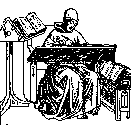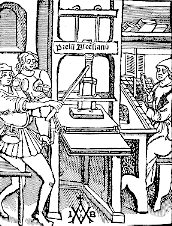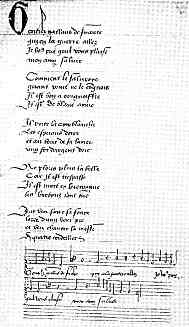


Image of an early printery.

If you are looking at this page without frames, there is more information about medieval writing to be found by going to the home page (framed) or the site map (no frames).
| The Written Word | |||
| A manuscript is any document written by hand. Until the middle of the 15th century, when printing came into use, all material transmitted by the written word was in manuscript form. This included books with a great variety of content, legal and business documents and records and eventually private correspondence. |  |
||
 |
The advent of the printing press rapidly changed the mode of production of books. Works requiring multiple copies could be replicated with far greater speed and efficiency than through generational sequences of hand copying. The selection of particular works for early inclusion in the printed corpus ensured that certain works became more widely disseminated through the literate community. The use of manuscript continued for much longer in the business and legal areas, where each document produced had to be unique. | ||
| An early printer's bookplate. | |||
| In the legal area, handwritten documents maintained a weightier significance even when printing could be used to produce standard formats. Hand lettered indentures and title deeds were produced well into the modern era. A certain technophobia was evident well before the computer era in the legal area, when exceptionally accurate typists with very wide typewriter carriages were employed to produce legal documents, which were large and imposing and were not allowed to contain any corrections. |  |
||
Image of an early printery. |
|||
| Clerks with steel nibbed pens were employed in droves well into the 20th century to copy endless pages of business records. They were replaced by serried ranks of secretaries in typing pools, many of whom have now frantically retrained to learn how to use computer accounting packages. | |||
| Within my lifetime it was considered rude to compose a personal letter on a typewriter, which should be reserved for business affairs. Now Grandmas get emails, and the lack of personal touch in the handwriting is compensated by the jpegs of the grandchildren and the dog. | |||
 |
The advent of printed books led relentlessly to a particular concept of written text, which should be standardised in content and form. Alterations to the text, even by its original author, were flagged in clearly numbered editions. The development of copyright laws ensured that text could not be appropriated in chunks by other authors. Mechanical reproduction ensured that multiple copies of any work were identical in every detail. This is not merely an improvement on an imperfect system for copying text, it is an entirely different conception of what text is all about. Medieval manuscript texts must not be seen simply as imperfect copies of each other, but as an organic and evolving system of text which modern book production has murdered. | ||
| A 15th century popular French song, written down in manuscript form. | |||
| To read anything written in the medieval era we must employ the skills of paleography to decode the handwritten forms. You can do that for yourself in another section of this web site. In this section there is a gradually expanding overview of what kinds of things medieval people actually wrote. This may challenge some of the stereotypes about medieval knowledge and writing practice. | |||
|
If you are looking at this page without frames, there is more information about medieval writing to be found by going to the home page (framed) or the site map (no frames). |
|||